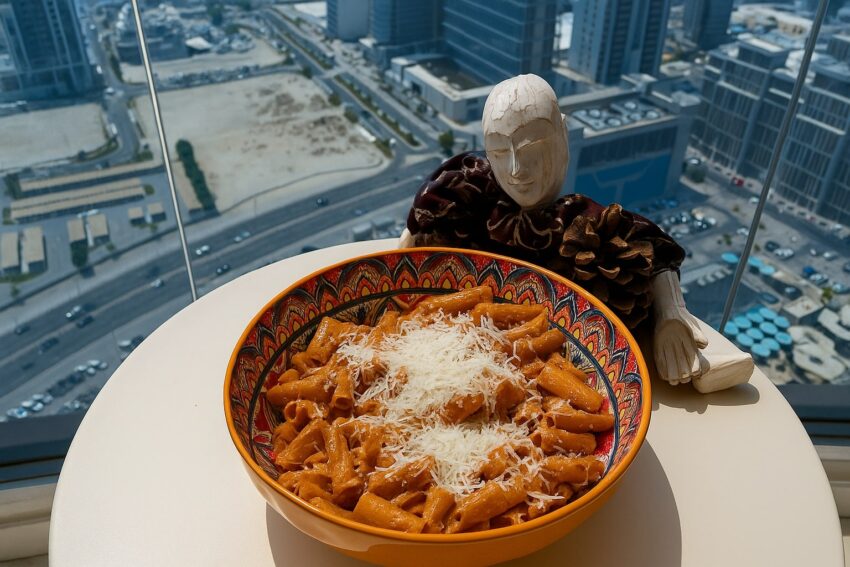Torn between having a drink or a great meal? Why not have both, sort of, with a delicious bowl of pasta alla vodka? It may not be the most traditional Italian dish, but its creamy sauce, subtle heat and unexpected splash of vodka are exactly what make it unforgettable. And hey, as a 14-year-old, this might be the only way I’ll be tasting vodka for the next seven years. Here’s how you can make your own rich and comforting vodka pasta at home.
Ingredients
For the pasta:
- 2 cups rigatoni
- 3 tbsp salt
- 4 cups water
For the sauce:
- 4 tbsp olive oil
- 2 shallots
- 1 garlic clove
- 2 tbsp tomato paste
- 1 tbsp chilli flakes
- 1 red cayenne chili (can substitute for any chili)
- 90 ml vodka
- 300 ml cream
- 1/3 cup pasta water
- 50 g parmesan cheese
- 2 basil leaves
- 3 cubes butter

Pasta
For this dish, penne or rigatoni are the go-to choices. Their ridged surfaces and hollow centers make them perfect for holding onto thick, creamy sauces which is exactly what you want in a vodka pasta.
Start by bringing a large pot of water to a rolling boil. Once it’s boiling, salt it generously. Remember, when you cook pasta, you’re not just softening it – you’re rehydrating it and giving it a chance to absorb some of that salted water. This step seasons the pasta from the inside out, making your final dish much more flavourful. Add your pasta and cook according to the package instructions until al dente.
After the pasta has cooked, don’t strain it out just yet. Using a ladle or just a mug, collect and store some of that pasta water, as we’ll be using that in our sauce.
Sauce
Start by finely mincing 1½ to 2 shallots and 1 clove of garlic. Fun fact: many Italian nonnas consider combining garlic and onions (or shallots) in the same dish a ‘sin’, as it can overpower delicate flavours. Good thing they’re not around in Dubai, I hope.
Heat some olive oil in a pan and gently sweat the shallots and garlic until soft and fragrant. Then, stir in your tomato paste and sauté over medium heat, letting it caramelise to deepen the flavour. For a bit of heat, add a sprinkle of chilli flakes and one finely chopped red chilli pepper.
Now for my favourite part, also where my mum starts questioning my life choices, some vodka. Use it to deglaze the pan, scraping up all those flavourful browned bits of tomato paste stuck to the bottom. This step lifts the rich, caramelised flavours into the sauce.
Vodka is added to this dish to enhance the sauce’s flavour and texture. Tomatoes contain compounds like carotenoids, esters and aromatics, many of which are fat-soluble or alcohol-soluble, but not water-soluble. Ethanol, found in vodka, is amphiphilic – it can dissolve both water and fat-soluble molecules. This helps dissolve flavourful compounds from the tomatoes and emulsifies the cream and tomato into a rich, cohesive sauce.

If you’re a young chef like me and your parents are a bit skeptical about the vodka, try explaining that it’s scientifically safe. The alcohol in the vodka evaporates at low temperatures, around 78°C (172°F), meaning what you’re left with are just the flavour compounds. Trust me – you won’t get tipsy.
If you’re cooking over an open flame, you can even try flambéing your sauce – yes, literally setting it on fire. Chefs use this technique not just for show but for flavour. It helps in two ways: first, by caramelising the natural sugars in the sauce, adding a rich, slightly nutty depth; and second, well, because it looks pretty damn cool.

Add as much cream to the sauce as you want. Adjust it so that it reaches the consistency that you desire. I used about 300 ml. Finish your sauce by adding a handful or two of parmesan cheese. Make sure you grate your own cheese, because that packaged nonsense doesn’t melt and incorporate well in the pan.
Add your pasta back to the sauce, as well as some of that starchy pasta water you saved from earlier, which would help in thickening everything up.
Plating
Plate your pasta in a bowl and finish with generous sprinkles of parmesan cheese. Enjoy that creamy sauce along with the slight bite of perfectly cooked pasta. At last, I can brag to my friends that I’ve tried vodka before they have!

